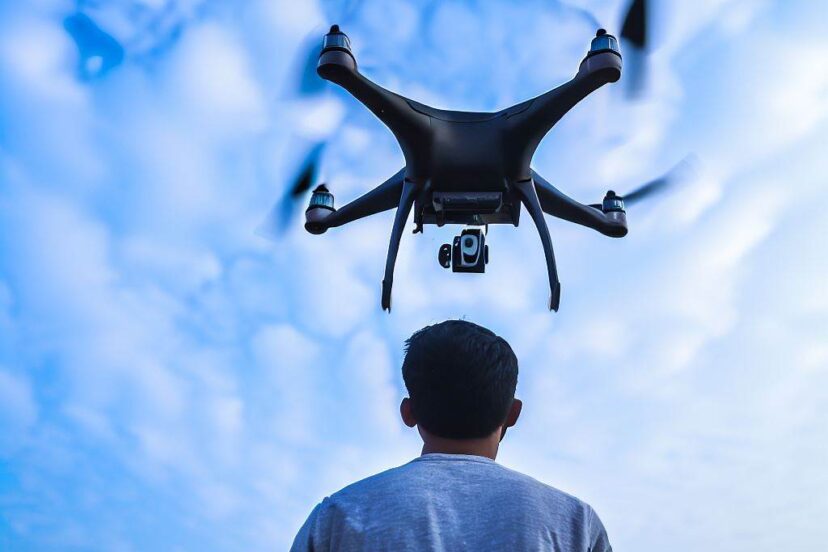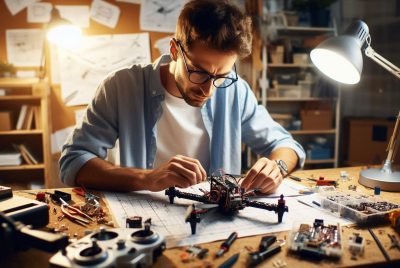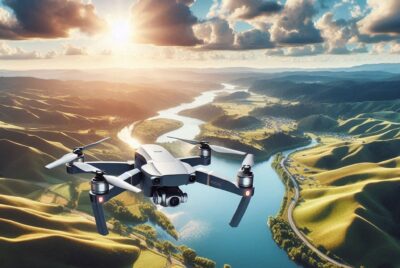How to Fly a Drone Like a Pro: Tips and Techniques
*We may earn a commission for purchases made using our links. Please see our disclosure to learn more.
How to Fly a Drone: A Beginner’s Guide to Taking Off and Navigating the Skies
Flying a drone for the first time is an exciting experience that combines technology with the freedom of aerial exploration. My introduction to “How to fly a Drone” began with understanding the basic functions, such as taking off, hovering, and landing. Knowing how to control a drone’s pitch, roll, yaw, and throttle is crucial, and it becomes intuitive with practice. To ensure a safe flight, it’s important to acquaint oneself with the pre-flight checks and the specific flight modes offered by the drone.

Before my first flight, I made sure to familiarize myself with the local regulations and airspace rules to fly responsibly. I took a knowledge test, which is often a regulatory requirement, to demonstrate my understanding of the operational do’s and don’ts. Ensuring that I am a trusted drone pilot means respecting privacy, avoiding restricted zones, and always maintaining a line of sight with the drone.
As a beginner, knowing when and where to fly is as important as knowing how to fly. I chose a calm day with minimal wind for my first flight and selected an open space free from obstacles. This allowed me to focus on the basic maneuvers without external pressures. With time and practice, my confidence grew, and so did my ability to capture stunning aerial footage while safely controlling the drone.
Understanding the Basics of How to Fly A Drone

Before I take to the skies, it’s vital for me to understand my drone’s controls and master basic maneuvers to ensure a safe and controlled flight.
Getting Acquainted with Your Drone
The first step in my drone flying journey is to familiarize myself with the drone’s components and the controller, often referred to as the transmitter. Here’s what I need to know about the main controls:
- Throttle: Controls the altitude; increasing throttle ascends, decreasing descends.
- Yaw: Rotates the drone left or right.
- Roll: Tilts the drone to fly left or right.
- Pitch: Tilts the drone to fly forwards or backwards.
I always ensure to read the drone’s manual to understand the specific functions of each button and switch on my transmitter.
Learning Basic Drone Maneuvers
Having knowledge about the controller, it’s time for me to learn and practice basic maneuvers. These fundamental techniques form the foundation of all drone flying skills:
- Hovering: The starting point of all maneuvers, where I learn to keep the drone steady in one place.
- Rotating: Using the yaw control, I practice rotating my drone to face different directions while maintaining its position.
- Flying in a Straight Line: I combine the use of roll or pitch with the throttle to fly in a straight line and then come to a stop by centering the controls.
As I progress, I’ll combine these controls to perform more complex maneuvers such as flying in a square pattern or executing a spiral. However, the most important technique I must learn is how to gently adjust the controls without overcorrecting, as this leads to smoother and more stable flights.
How to Fly A Drone: Pre-Flight Preparations

Before I take to the skies, I ensure my drone’s readiness and compliance with regulations. This includes checking my equipment’s settings and being aware of the weather and no-fly zones.
Checking Drone and Controller Settings
Drone Battery:
- Ensure the battery is fully charged.
- Perform a battery health check.
Calibration:
- Calibrate the drone’s compass.
- Check IMU calibration.
Firmware and Software Updates:
- Update the drone and remote controller firmware to the latest version.
- Ensure all software is up-to-date.
Remote Controller:
- Verify the remote controller’s battery level.
- Check the connection to the drone.
Drone Registration:
- Confirm my drone is registered and marked with a registration number, if required.
Safety Pre-Flight Checklist:
- Inspect the drone for any physical damage.
- Ensure propellers are secure and undamaged.
- Check the camera/gimbal cover is removed and the lens is clean.
Assessing Weather Conditions and No-Fly Zones
Weather Conditions:
- Check the weather forecast for wind, rain, or other adverse conditions.
- Assess the impact of current weather on the drone’s performance.
No-Fly Zones:
- Consult local regulations and maps for no-fly zones.
- Verify I am authorized to fly in the planned area and that there are no temporary restrictions.
By meticulously checking each of these elements, I can confidently ensure a safe and legal flight experience.
Advanced Drone Operations

Advanced drone operations require precision and skill, especially when executing complex flight patterns and maneuvers. It is essential to master hovering and rotation before progressing to challenging tasks such as dynamic aerial videography.
Mastering Hovering and Rotation Techniques
Hovering is a fundamental skill where I maintain the drone’s position in the air, an essential prerequisite before attempting any advanced maneuvers. To hover effectively, I gradually adjust the throttle to find the sweet spot where the drone remains at a constant altitude. I remain vigilant to subtle changes in wind and drone behavior, making minute control inputs to maintain stability.
- Techniques for Stable Hovering:
- Gradual throttle adjustment
- Constant monitoring of altitude and position
- Fine-tuning with drone’s control sticks
When rotating the drone, I use the yaw control to turn the drone left or right while maintaining its position. This skill is crucial for changing the direction the drone’s camera is facing without altering its flight path.
- Basic Rotation Steps:
- Keep the drone steady in a hover.
- Apply gentle pressure on the yaw control to initiate rotation.
- Adjust pitch and roll to maintain the drone’s position if necessary.
How to Fly A Drone: Understanding Different Flight Modes
Drone flight modes offer me a range of control levels, from fully manual to more automated, GPS-assisted flying. As an advanced operator, I know how to switch between modes to best suit the scenario. In GPS Mode, the drone can hover more accurately and follow pre-determined paths, making it ideal for capturing smooth drone video footage.
- Manual Mode (Acro):
- Full control over the drone’s movement with no stabilization.
- Best for acrobatic flying and precise maneuvers.
- GPS-Assisted Modes:
- Helps maintain stability and position.
- Useful for consistent tracking shots and aerial photography.
Understanding and using these flight modes is integral. I practice taking off and landing in various modes to grasp their nuances, preparing me for intricate flight patterns and operations that demand a higher level of control.
How to Fly A Drone: Navigating Legal and Safety Regulations

I understand that abiding by legal and safety regulations is fundamental when flying a drone. My focus is ensuring that I comply with FAA rules and uphold the safety guidelines for responsible drone operation within the National Airspace System.
Registration and Compliance
I make sure to register my drone with the Federal Aviation Administration (FAA) if it weighs more than 0.55 pounds (250 grams) and less than 55 pounds (25 kilograms). For this, I use the FAA DroneZone website and create a Part 107 account for non-recreational purposes. By doing this, I avoid legal trouble and ensure my operations are recognized by the regulatory body.
- Part 107 Account: Creation is essential for commercial pilots.
- FAA DroneZone: The platform for registering drones.
Avoiding Sensitive Areas and Maintaining Visual Line of Sight
I always keep my drone within visual line of sight to maintain full control and situational awareness. Additionally, it is crucial to avoid sensitive areas such as government facilities, airports, and military bases, where drone flying is typically prohibited.
- Visual Line of Sight: Ensures personal control over the drone.
- Sensitive Areas: Always avoid these to stay compliant with laws.
By adhering to these guidelines and regulations, I contribute to a safer drone flying experience for myself and others.
How to Fly A Drone: Enhancing Your Drone Experience

To truly elevate my drone flying capabilities, I focus on two core aspects: capturing stunning visuals and making the most of my drone’s features and accessories.
Capturing High-Quality Photography and Videography
Camera and Gimbal: The heart of aerial photography and videography is a high-quality camera coupled with a stable gimbal. I ensure my drone’s camera has a high resolution and framerate capability for crisp images and smooth footage. The gimbal must provide stability and control, allowing me to capture steady shots even during windy conditions.
Photography Techniques:
- To maximize image quality, I use manual settings on my camera to adjust for lighting conditions.
- I practice various compositions to create more dynamic and interesting photographs.
Videography Tips:
- I shoot at different angles and altitudes to add depth to my videos.
- I develop smooth piloting skills for seamless transitions and movements in my footage.
Paths for Professional Drone Pilots:
- Drone Pilot Ground School: Enroll in a certification program to deepen my knowledge and enhance my skills.
- Professional Development: Continuously practice and update my knowledge to maintain a professional edge in drone piloting.
Exploring Drone Features and Accessories
Features: I learn about my drone’s sensors and flight modes to fully utilize its potential. Understanding features like obstacle avoidance, GPS tracking, and return-to-home functions is crucial for safe and efficient piloting.
Essential Accessories:
- Extra batteries: To extend my flight sessions.
- Propeller guards: For added safety during indoor flights.
Advanced Accessories:
- ND filters: For better control over the camera’s exposure in bright conditions.
- Carrying cases: To protect my drone during travel.
By focusing on these elements, I enhance my drone experience, whether pursuing it as a hobby or steering towards becoming a professional drone pilot.
FAQs About How to Fly A Drone
In my experience, addressing frequently asked questions is crucial for beginners to safely and effectively operate drones. Below, I’ve outlined answers to some common inquiries new drone pilots often have.
1. What are the key steps to flying a drone for the first time?
To fly a drone for the first time, I start by ensuring the drone is fully charged and that I’ve read the manual thoroughly. Then I check for any airspace restrictions, register my drone if necessary, and find a spacious, open area away from people. The next step is to perform pre-flight checks, understand the basic controls, and start with simple maneuvers to gain confidence.
2. What are some essential tips for flying a drone using a remote control?
I keep in mind that maintaining line of sight is paramount when piloting with a remote control. It’s essential to practice using the joystick controls in a controlled environment to get comfortable with the drone’s movements—such as ascending, descending, and turning.
3. How can I learn to fly a drone using my smartphone?
Learning to fly a drone with my smartphone involves downloading the drone manufacturer’s app and familiarizing myself with the on-screen controls. Calibration and virtual tutorials within the app can be incredibly helpful for getting accustomed to the touch-based controls before taking the drone out for an actual flight.
4. Are there specific apps recommended for flying drones?
I recommend using the official apps provided by the drone’s manufacturer, as these are optimized for their specific models. Some widely used examples include DJI GO 4 for DJI drones, and the Parrot FreeFlight for Parrot drones. These apps usually offer the most reliable and comprehensive functionality for flying their respective drones.
5. What common mistakes should beginners avoid when flying drones?
From my experience, beginners should avoid flying in poor weather conditions, losing sight of the drone, and neglecting battery levels. I also stress not to fly too high or too far too soon, as it’s easy to encounter difficulties that can lead to loss of the drone or accidents.
6. What are the basic drone flying fundamentals for new users?
The basic fundamentals for new users include understanding the drone’s flight modes, mastering takeoff and landing techniques, and learning how to hover and control the drone in various flight conditions. I advise always staying aware of surroundings and maintaining control to ensure safety and enjoyment while flying.




